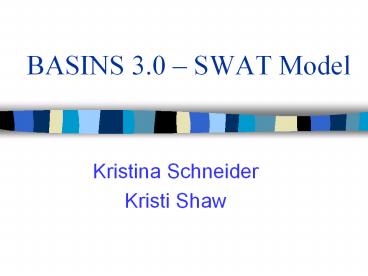BASINS 3.0 – SWAT Model - PowerPoint PPT Presentation
Title:
BASINS 3.0 – SWAT Model
Description:
BASINS 3.0 SWAT Model Kristina Schneider Kristi Shaw BASINS 3.0 SWAT Model Kristina Schneider Kristi Shaw Focus of Presentation SWAT stands for Soil and Water ... – PowerPoint PPT presentation
Number of Views:322
Avg rating:3.0/5.0
Title: BASINS 3.0 – SWAT Model
1
BASINS 3.0 SWAT Model
- Kristina Schneider
- Kristi Shaw
2
Focus of Presentation
3
SWAT An Overview
- SWAT stands for Soil and Water Assessment Tool
- Spatial Scale watershed or river basin
- Data Organization subbasins or hydrologic
response units (HRUs) - Time scale Continuous time model (long term
yield model) - based on a daily scale
- Not for a single event
- Data Inputs weather, soil properties,
topography, - vegetation, and land management
practices - From the BASINS databases
4
SWAT An Overview
- SWAT separates soil profiles into 10 layers to
model inter - and intra-movement between layers.
- The model is applied to each soil layer
independently starting - at the upper layer.
- SWAT soil water routing feature consists of four
main pathways - 1. soil evaporation
- 2. plant uptake and transpiration
- 3. lateral flow
- 4. percolation.
5
Soil Evaporation
- Actual soil water evaporation stimulated using
exponential - functions of soil depth and water
content.
- Potential soil water evaporation considering
ground covering - Es potential soil water evaporation rate
(mm/day) - EAsoil cover index
- Eopotential evaporation rate at the surface
(mm/day)
- Potential soil water evaporation for a layer
- SEV potential soil water evaporation rate for
layer (mm/day) - EVtotal soil water evaporation in mm from
soil of depth Z in mm
6
Plant Uptake and Transpiration
- SWAT model computes evaporation from soils and
- plants by Eo 128 (ho)
- Plant transpiration function potential
- Evapotranspiration and
- Leaf area index (area of plant leaves relative
to - area of the HRU
- Potential evapotranspiration calculated with
- Hargreaves
- Priestley-Taylor
- Penman-Monteith.
7
Lateral Flow
- The stream flow contribution below the surface
- but above saturated zone.
- It is calculated simultaneously with
redistribution - using a kinematic storage model.
- The model accounts for variation in
conductivity, - slope, soil water content, and allows flow
upward to surface.
- Kinematic storage model finite difference mass
continuity equation
8
Percolation
- Storage routing technique combined with a
crack-flow model to predict flow
through each soil layer - Cracked flow model allows percolation of
infiltrated rainfall though soil water content
is less than field capacity. - Portion that does become part of layer stored
water cannot percolate until storage exceeds
field capacity.
- Storage routing technique based on the
following equation - Swisoil water contents at end of the day
(mm) - Swoisoil water contents at beginning of the
day - TTtravel time through layer (hr)
9
Summary































